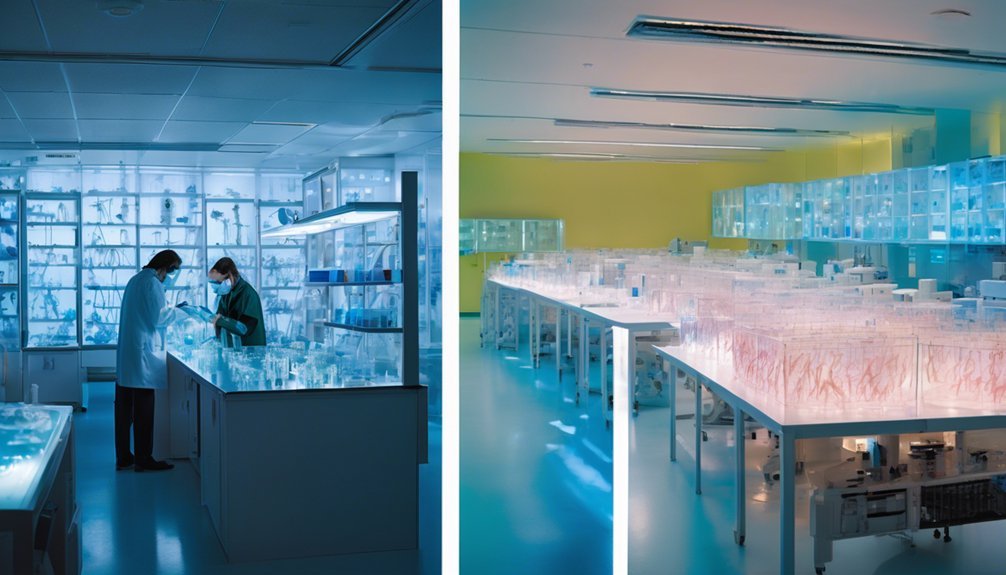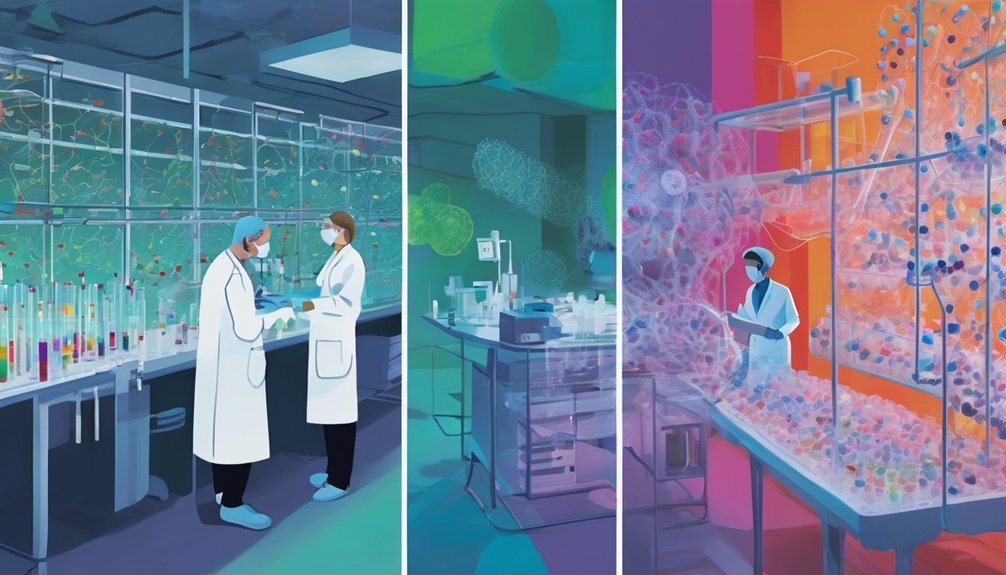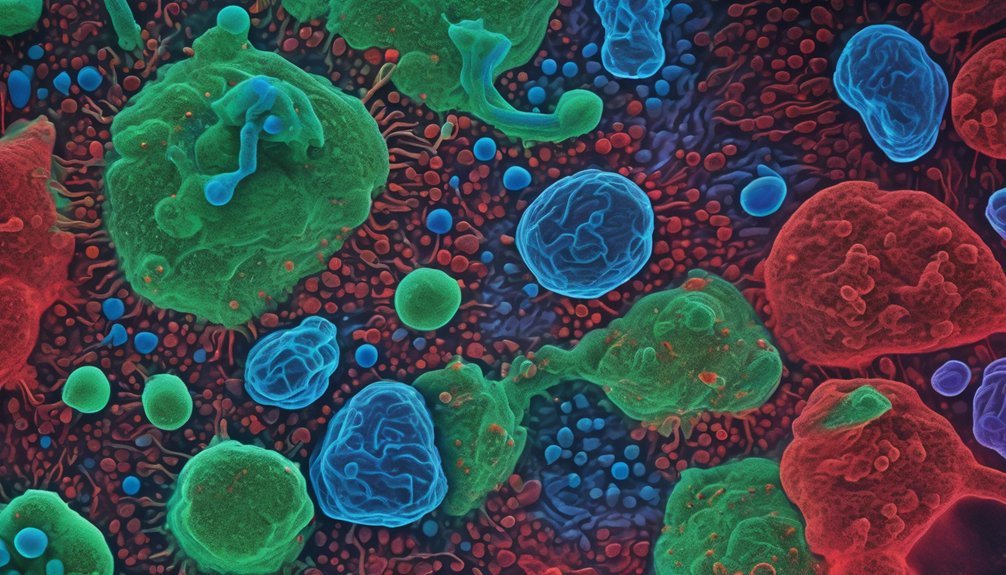In parasite drug cancer research, the gap between preclinical findings and human trials is troubling. You might wonder why promising treatments fail to translate effectively from animal models to human patients. Discrepancies in drug metabolism and immune responses often lead to unexpected outcomes, significantly affecting clinical trial success rates. As you explore this complex landscape, consider the implications of these challenges on future drug development and the potential solutions that could bridge this critical divide.
Key Takeaways
- Preclinical research often fails to mimic human physiology, leading to discrepancies in drug efficacy observed in human trials.
- Variability in immune responses between animal models and humans can skew results, highlighting a significant gap in drug testing.
- Dosing challenges and preclinical toxicity issues frequently contribute to failures in transitioning from preclinical to clinical trials.
- Biomarkers are essential for bridging gaps, as they improve the understanding of treatment responses and patient selection for clinical trials.
- Collaborative efforts in drug development are crucial for addressing complexities, enhancing the translation of preclinical findings to human applications.
Understanding Parasitic Infections and Their Link to Cancer

While many may not realize it, there’s a growing body of evidence linking parasitic infections to cancer development. Research indicates that specific parasitic mechanisms can alter immune responses, potentially leading to malignancies.
For instance, certain parasites evade the immune system, creating chronic inflammation, which is a recognized cancer risk factor. Understanding these cancer connections opens new avenues for treatment strategies.
By targeting the underlying parasitic infections, you can’t only address the immediate health concerns but also mitigate long-term cancer risks. This approach requires a collaborative effort among researchers, healthcare providers, and public health officials to develop effective interventions.
Overview of Preclinical Research in Drug Development
Research on the links between parasitic infections and cancer highlights the importance of exploring new therapeutic avenues, particularly through drug development.
Preclinical research serves as a critical foundation for assessing drug efficacy before reaching human trials. Here are some key elements of preclinical methodologies:
- In vitro testing: Evaluates drug effects on cell cultures to identify potential therapeutic impacts.
- In vivo studies: Assesses the drug’s safety and efficacy in animal models, providing insights into biological responses.
- Pharmacokinetics: Analyzes how drugs are absorbed, distributed, metabolized, and excreted, ensuring optimal dosing strategies.
The Role of Animal Models in Preclinical Studies
Animal models play a crucial role in preclinical studies, providing invaluable insights into the complex interactions between parasitic infections and cancer.
When you consider animal model selection, it’s essential to choose species that closely mimic human disease pathology. This ensures that the findings are relevant and translatable.
For effective preclinical validation, these models must demonstrate reproducibility and predictive accuracy, allowing researchers to evaluate drug efficacy and safety before human trials.
By employing well-characterized animal models, you can uncover critical biological mechanisms and assess therapeutic strategies.
Your careful selection of these models directly impacts the success of future interventions, ultimately benefiting patients facing the dual challenges of parasitic diseases and cancer.
Challenges in Mimicking Human Physiology

Selecting appropriate animal models is only the beginning; the real challenge lies in effectively mimicking human physiology. You’ll encounter significant hurdles when translating drug efficacy from animals to humans due to inherent biological differences.
- Metabolism Variability: Animals metabolize drugs differently, impacting efficacy.
- Immune Response Discrepancies: Variations in immune system functions can skew results.
- Tissue Architecture Differences: The structural differences in organs can alter drug absorption and action.
These factors complicate the prediction of how treatments will perform in human trials.
Without accurate models that reflect human physiology, the pathway from preclinical findings to clinical success remains fraught with uncertainty, hindering the advancement of effective parasite cancer therapies that serve those in need.
Common Reasons for Preclinical Failures
While various factors contribute to preclinical failures in parasite drug cancer research, several common reasons consistently emerge.
One significant issue is preclinical toxicity, where compounds that appear effective in vitro cause adverse effects in vivo. These unexpected toxicities often derail promising candidates before they reach human trials.
Additionally, dosing challenges complicate the development process; determining the optimal dose that maximizes efficacy while minimizing side effects is crucial yet often poorly executed in preclinical studies. Inaccurate dosing can lead to misleading results, making it difficult to predict how a drug will behave in humans.
Addressing these common pitfalls is vital for improving the success rate of transitioning from preclinical research to clinical applications, ultimately serving patients more effectively.
Translational Research: Bridging the Laboratory and Clinic
Preclinical failures highlight the pressing need for effective translational research in parasite drug cancer studies.
Bridging the gap between the lab and clinic is essential for advancing treatment options. To achieve this, consider implementing robust translational strategies and innovative research methodologies that prioritize patient outcomes.
- Foster collaboration between researchers and clinicians
- Utilize patient-derived models for more relevant data
- Focus on adaptive trial designs to enhance flexibility
Importance of Biomarkers in Drug Development

Biomarkers play a crucial role in drug development, as they provide essential insights into disease mechanisms and treatment responses. Understanding biomarker discovery enhances our ability to identify patient subgroups that may benefit from specific therapies, paving the way for targeted treatments.
This not only improves clinical relevance but also optimizes resource allocation in research endeavors. By integrating biomarkers into the drug development process, you can better predict therapeutic outcomes and monitor efficacy, ultimately leading to more successful clinical trials.
Furthermore, reliable biomarkers can help mitigate risks by identifying potential adverse effects early on. Emphasizing the importance of biomarkers ensures that you’re actively contributing to more effective, personalized treatment strategies in parasite drug cancer research.
Variability in Human Responses to Treatments
Understanding the variability in human responses to treatments is essential for optimizing therapeutic strategies in parasite drug cancer research. This variability can significantly influence outcomes, highlighting the need for a tailored approach.
Here are some key factors to consider:
- Individual genetic variations: Genetic differences can affect drug metabolism and efficacy, leading to varying responses among patients.
- Treatment adherence factors: Patients’ commitment to prescribed regimens can directly impact treatment success, making adherence a critical component of effective therapy.
- Environmental influences: External factors, such as diet and lifestyle, can also modify the effectiveness of treatments.
Regulatory Hurdles in Advancing New Therapies
Variability in human responses to treatments underscores the complexity of developing new therapies for cancer related to parasitic infections.
Navigating the intricate regulatory frameworks poses significant challenges for researchers. These frameworks, designed to ensure safety and efficacy, can inadvertently slow down the approval processes for promising new therapies.
You’ll find that the lengthy timelines and extensive documentation required often hinder timely access to innovative treatments. Moreover, inconsistent regulations across regions can lead to further delays.
For researchers and healthcare advocates alike, understanding these hurdles is crucial. By addressing regulatory inefficiencies and advocating for streamlined processes, you can help bridge the gap between laboratory discoveries and real-world applications, ultimately improving patient outcomes in the fight against cancer linked to parasitic infections.
Case Studies of Failed Translations

While many promising therapies have emerged from the lab, translating these innovations into effective cancer treatments for patients suffering from parasitic infections has often encountered significant roadblocks.
Case analysis reveals several notable translation failures:
- Lack of preclinical relevance: Some successful compounds in vitro failed to show efficacy in human trials.
- Inadequate dosing strategies: Dosage regimens effective in animal models often don’t translate to humans.
- Biological complexity: The multifaceted interactions between cancer cells and parasites complicate treatment outcomes.
These case studies highlight the importance of a thorough understanding of both parasite biology and cancer mechanisms.
Recognizing these pitfalls is crucial for developing more effective therapies, ultimately enhancing patient outcomes and advancing the field of parasite drug cancer research.
Innovations in Preclinical Testing Methods
Recent advancements in preclinical testing methods are addressing the significant gaps identified in previous case studies of failed translations. You’ll find that novel assays and high throughput screening technologies are revolutionizing the way researchers evaluate potential parasite drugs. These innovations help predict human responses more accurately, thus improving the chances of successful clinical trials.
| Method | Benefits |
|---|---|
| Novel Assays | Enhance specificity and sensitivity in detection |
| High Throughput Screening | Accelerates the evaluation process, saving time |
The Future of Parasite Drug Development
As advancements in technology and our understanding of parasitic diseases continue to evolve, the future of parasite drug development holds promising potential.
Researchers are now focusing on:
- Identifying novel compounds that target specific parasitic pathways
- Exploring innovative delivery methods for enhanced efficacy
- Strengthening clinical applications through rigorous testing and collaboration
These efforts aim to bridge the gap between preclinical findings and real-world applications.
By emphasizing evidence-based approaches, scientists can better tailor treatments to meet patient needs. The integration of novel compounds into therapeutic regimens not only enhances treatment outcomes but also addresses the pressing challenges posed by drug resistance.
Collaborative Approaches to Enhance Research Outcomes

Collaborative approaches are essential for advancing research outcomes in parasite drug development, especially given the complexity of parasitic diseases.
By leveraging collaborative platforms, you can connect various stakeholders, including academia, industry, and non-profits, to foster innovative solutions.
Establishing strong research partnerships enhances resource sharing, accelerates knowledge transfer, and improves experimental designs. These alliances allow you to pool expertise and funding, which is crucial for navigating the challenges of drug discovery.
Strong research partnerships enhance resource sharing and knowledge transfer, vital for overcoming drug discovery challenges.
Moreover, joint efforts in data collection and analysis can lead to more robust findings, ultimately translating into better therapeutic strategies.
Embracing collaborative methods not only enriches the research landscape but also ensures that your efforts contribute meaningfully to global health challenges.
Frequently Asked Questions
How Do Parasitic Infections Influence Overall Cancer Treatment Outcomes?
Parasitic infections can significantly complicate cancer treatment outcomes by weakening the immune system, altering drug metabolism, and increasing inflammation. Recognizing these factors helps tailor more effective treatment strategies, ultimately improving patient care and survival rates.
What Are the Ethical Considerations in Using Animals for Preclinical Testing?
You might think animal testing lacks ethical merit, but ensuring animal welfare through strict research regulations is vital. Balancing scientific progress with humane treatment fosters advancements while respecting the lives that contribute to our understanding.
How Can Patient-Specific Factors Impact Drug Efficacy in Human Trials?
Patient-specific factors, like genetic variability and biomarker identification, significantly impact drug efficacy in human trials. Understanding these factors enhances treatment personalization, ensuring that therapies align with individual patient profiles for better outcomes and improved healthcare.
What Role Do Funding and Resources Play in Research Gaps?
Funding disparities and resource allocation significantly impact research gaps. When you prioritize equitable distribution of financial support, you enhance collaboration and innovation, ultimately leading to more effective solutions that serve diverse patient populations in need.
Are There Emerging Technologies Improving Preclinical Testing for Parasite Drugs?
Yes, emerging technologies like in vitro assays, high throughput screening, and machine learning are enhancing preclinical testing for parasite drugs. These advancements enable efficient biomarker discovery, ultimately accelerating the development of effective treatments for those in need.
Conclusion
In bridging the chasm between preclinical research and human trials, we must cultivate innovative methodologies like seeds in fertile soil. By refining our models and biomarkers, we can illuminate the pathways that lead to effective treatments for parasitic infections linked to cancer. As we forge collaborative efforts, the future of parasite drug development can transform from a foggy horizon into a clear dawn, where the promise of successful therapies becomes a tangible reality, benefiting countless lives.




